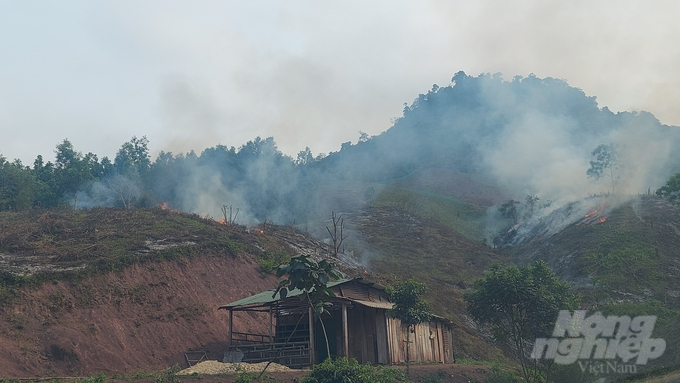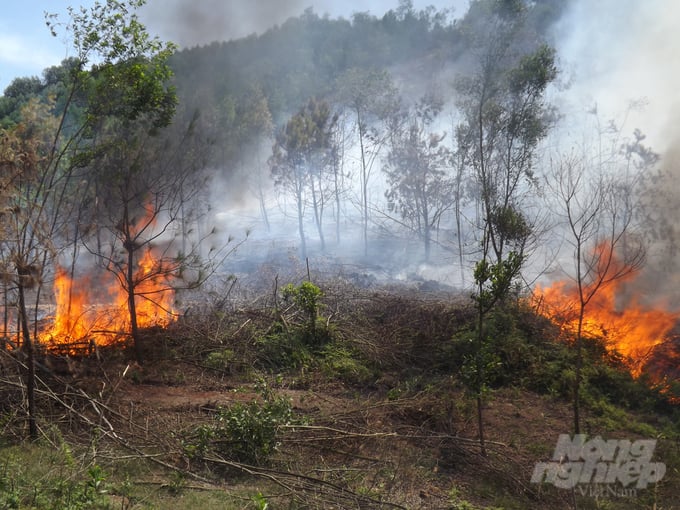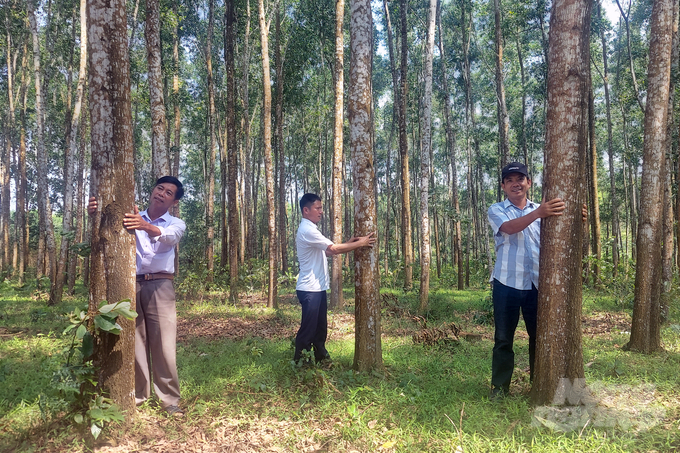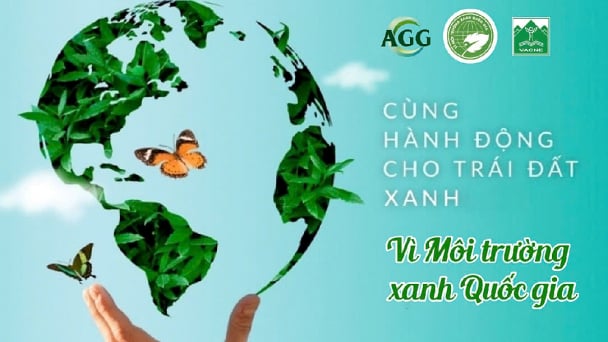May 19, 2025 | 13:26 GMT +7
May 19, 2025 | 13:26 GMT +7
Hotline: 0913.378.918
May 19, 2025 | 13:26 GMT +7
Hotline: 0913.378.918
According to Mr. Vo Thanh Tu, Vice Chairman of Cam Thuy commune People's Committee in Le Thuy district, Quang Binh province, the majority of local forest fires have been caused by households burning post-harvest forest vegetation to replant. Following settlement, the party responsible for starting forest fires was fined a significant sum of money to cover the damages to affected households.
The local government has taken drastic actions to address the serious consequences of forest vegetation burning. Accordingly, the local government encouraged the offenders to reconcile and compensate the affected party.

The burning of post-harvest forest vegetation has had negative environmental effects. Photo: Vo Dung.
“We have attempted to advise local people against burning forest vegetation to no avail. After forest fire incidents, we have encouraged the parties to reach an agreement on compensation. In reality, the majority of forest owners are aware of the dangers of forest vegetation burning. However, many forest owners opt to burn vegetation in order to replant because they only have a small timber forest area and they do not have any legal obligations. This type of problem requires a long-term soluion", Mr. Tu shared.
According to Mr. Le Tai Hanh, a member of Thuy Tay Agricultural Service Cooperative in Cam Thuy commune, the burning of post-harvest forest vegetation is mostly exclusive to small timber plantations with fragmented forest areas.
In addition to the growth of the afforestation movement under the sustainable forest management certificate in Cam Thuy commune, forest growers have stopped the habit of burning vegetation after harvesting. Other local forest owners outside of FSC-certified forest areas have also voluntarily given up on the vegetation burning practice. This improvement can be attributed to the growing awareness of the local forest owners.
There are many cooperatives in Quang Tri province that currently focuses on sustainable afforestation. Members of these cooperatives mainly cultivate large timber forests with the aim of acquiring the FSC certification and forming partnerships with companies to assure steady output. Accordingly, forest owners must stop their habit of burning post-harvest vegetation to achieve FSC-certified large timber forests.
Quang Tri province currently houses over 120,000 hectares of production forests. The province is also among the first in Vietnam to receive a certification from the Forest Stewardship Council for sustainable forest management. The certificate was granted to organizations and households with a total acacia forest area of nearly 16.2 thousand hectares.

Post-harvest forest vegetation burning damages the ecosystem, increases emissions, and raises the risk of forest fires. Photo: Thanh Nga.
According to the Resolution issued by the 17th Provincial Party Congress for the term of 2020-2025, Quang Tri province plans to grow an additional 5,000 hectares of FSC-certified large timber forests in the five districts of Hai Lang, Cam Lo, Trieu Phong, Gio Linh and Vinh Linh. In addition, the province aims to reach at least 30 thousand hectares of forest by 2030.
Quang Tri Provincial People's Committee promulgated a plan in 2020 in response to climate change from 2021 to 2030, with a vision towards 2050. Accordingly, the province aims to identify solutions to adapt to climate change and reduce greenhouse gas emissions.
It is expected that the burning of vegetation in Quang Tri province will reduce drastically in the near future. Consequently, the amount of CO2 released into the environment by forest vegetation burning will also decrease.
However, Mr. Le Chi Nghia, Deputy Head of Forest Use Management Division under Quang Tri Department of Forest Protection, believes that most local are not interested in cultivating FSC-certitifed large timber forests.
In addition, forest growers receive little support due to the delay in the implementation of policies pertaining to the cultivation of large timber forests. These are major obstacles that impair Quang Tri province's determination to plant forests in response to climate change.
Mr. Nguyen Van Luc, Director of Thuy Dong Agricultural Service Cooperative affirmed that sustainable and efficient afforestation requires the conversion from from small timber forest to FSC-certified large timber forest. As a result, requirements for the FSC certificate will automatically alleviate the issue of vegetation burning. The FSC certification will allow local wood materials to reach the global market as well as increase the value of planted forests.

Many households in Cam Thuy commune, Le Thuy district, Quang Binh province have stopped the habit of burning forest vegetation after harvesting. Photo: Vo Dung.
At the Workshop on Reducing GHG emissions through the management of organic post-havest materials in Quang Tri province, Dr. Do Dang Teo, Deputy Director of the Sustainable Forest Management Component (under the USAID Sustainable Forest Management and Biodiversity Conservation project) said that forest growers in many countries around the world have abandoned the habit of burning vegetation after harvesting.
“The management of organic post-havest materials (or vegetation) through non-burning methods has been studied extensively by many countries around the world such as Australia, Brazil, Indonesia, Malaysia, etc. It has become a compulsory requirement in the planting, nurturing and protection of forests. In 1995, the Indonesian government issued a policy forbidding the burning of post-harvest forest vegetation", Dr. Teo shared.
According to experts at the workshop, there would be 32.4 tons of dry organic material leftover for every hectare of post-harvest six-year-old acacia forest, which is equivalent to 55.8 tons of CO2. The burning of this organic material will hypothetically release 55.8 tons of CO2 into the environment per one hectare of planted forest. Indonesia's method of managing post-harvest organic material has increased the wood yield of Acacia mangium by 15% compared to that of the burning method. In addition, the burning of post-harvest vegetation affects the branch and canopy formation of certain acacia species due to environmental factors such as soil, water, temperature, and rainfall changes.
The USAID Sustainable Forest Management and Biodiversity Conservation project replants 100,000 hectares of acacia every year in Vietnam. If post-harvest organic materials were burned during this process, they would release approximately 5.5 million tons of CO2 into the environment, accounting for nearly 1% of Vietnam's total CO2 emissions in 2022.

Forests with post-harvest vegetation burning suffer from lower productivity compared to those without. Photo: Thanh Nga.
Mr. Vu Van Hung, Deputy Head of the Forestry Project Management Board and Director of the Central Management Board of the USAID Sustainable Forest Management and Biodiversity Conservation project, said: Non-burning management of post-harvest organic materials is an ecological and sustainable production forest management practice. This globally-preferred method helps enhance the forest's value, stabilize the life of small-scale forest growers and contribute to the GHG emission reduction roadmap of Vietnam.
“Japan, one of Vietnam's top export destinations for wood products, has raised the requirements for imported pellets' quality and sustainable development factors in 2023.
According to new regulations set by the European Union, coffee, cocoa, timber and rubber products originating from degraded forested areas are barred from entry into this market. If forest growers want to export wood and wood products to Japan, Korea, the US and the EU, they must improve their management of post-harvest organic materials in an environmentally friendly manner", emphasized Ms. Hoang Thi Nguyen Hai from Biomass Fuel Vietnam Co., Ltd.
Translated by Nguyen Hai Long

(VAN) 14 out of 35 domesticated elephants in Dak Lak province have had their living conditions improved, with 11 of them currently participating in the non-riding elephant tourism model.

(VAN) Muong Nhe Nature Reserve hopes that being upgraded to a national park will lay the foundation for forest protection efforts to be carried out in a systematic, modern, and sustainable manner.
/2025/05/16/3923-2-171845_52.jpg)
(VAN) Lower costs, higher yields, and improved soil quality are outstanding benefits that soybeans bring when integrated into the crop rotation system.

(VAN) The 'For a Green National Environment' programme aims to promote a green lifestyle, support businesses in implementing ESG practices, and turn Net Zero commitments into concrete actions.

(VAN) Cold-barn systems efficiently manage environmental and temperature conditions, which aids in the prevention of respiratory diseases in pigs and protects them from the vectors that transmit African swine fevers.

(VAN) To tackle challenges, the project 'Addressing key technical bottlenecks in the grouper supply chain in Vietnam' has been underway since 2024.

(VAN) The project 'Disease-Resilient and Sustainable Cassava Production Systems in the Mekong Region', funded by the Australian Center for International Agricultural Research (ACIAR), is being implemented from 2024 to 2028.